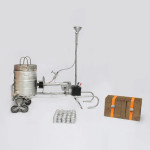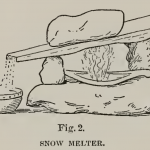Reader Paul Blais sends us an interesting idea:
“I’ve been following your website for years and I like it very much. I’ve been reading your article from 2018 about off-grid compressed air energy storage and I’ve been thinking about a possible solution regarding the varying pressure problem which you mention about small scale, low pressure vessels.
What about using a constant pressure reservoir? My idea is to use a long airtight bag stored in a trench and covered with sand, that would inflate and deflate pushing the sand up and down. The height of the sand column would determine the inside pressure of the bag, which would remain constant across it’s whole inflation range. The sand would also act as a thermal mass, taking and restoring heat to the air.
I’ve read that similar storage ideas exist [1] but involve putting the bags deep underwater, which is not practical for off-grid purposes. Unlike a deep-water reservoir, a bag put under sand would not try to float, so there would be no need for complex anchors at the bottom.”
[1] http://euanmearns.com/a-review-of-underwater-compressed-air-storage/
Update. Reader Erich Wälde comments:
> Unlike a deep-water reservoir, a bag put under sand would not try to float, so there would be no need for complex anchors at the bottom.
This is not entirely correct. The bag will work it’s way up! Around the edges some sand will always travel from “above” the bag to “below” the bag — unless the bag has considerable “flaps” around it, which will extend well into the neighboring area, i.e. complex anchoring, I’m afraid.
Other example: I bought a house several years back. In the garden there is an underground tank, which was used to store oil (heating). Heating was changed to use natural gas rather than oil, so the tank became unused. In order to fully abandon its operation, we had to get it cleaned out AND we had to show that the tank is not in the parking lot. If it were there, then it would have to be filled up with concrete or sand. Otherwise it would work it’s way up, very slowly, due to its buoyancy force. This is in Germany and local administration knows about each underground tank. Its well regulated.
So: You can’t trick physics 🙂





